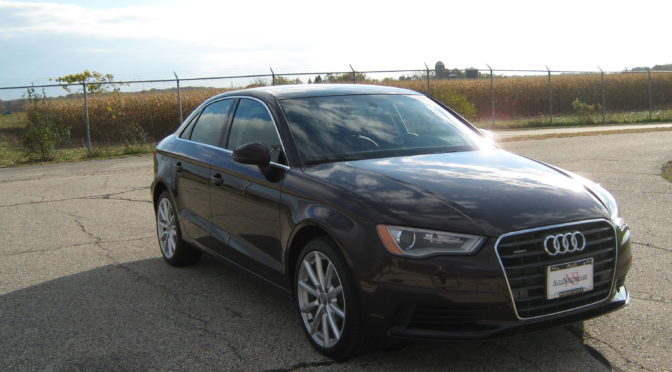This is the fifth part of a series of the vehicles you want to be in if you’re about to experience a rollover. The first part dealt with the best minivans for surviving a rollover last year, and the second and third parts dealt with the best 2016-model year cars and small SUVs and crossovers for rollover survival. The fourth ranked the best 2- and 3-row family SUVs. Today’s post will deal with luxury cars; many people need more space or comfort than that available in sub-, compact, or mid-sized cars, but aren’t interested in SUVs or minivans. By the end of it, I want you to know what the best luxury-minded cars are when it comes to rollover avoidance and survival.
I’ve written a series of similar articles on safe vehicles for side impact collisions (here are the safest 2015 cars, small cars, minivans, and SUVs and crossovers for surviving side impacts). Now let’s take a look at which factors play a role in surviving a rollover in a given vehicle.
What does a luxury car need to keep my loved ones safe before or during a rollover?
1. Electronic stability control. ESC reduces rollover risks by acting like an advanced version of ABS; it can brake individual tires to help keep your vehicle headed in the same direction as your steering wheel. The NHTSA estimates it cuts the risks of a fatal single vehicle crash by a full 50%. This is technology you want on your side whenever you’re behind the wheel (much like the seat belt and frontal airbag).
2. Rollover-sensitive side airbags with head and torso coverage. Once you’ve got ESC, you’ll also want side airbags programmed to activate when a rollover is imminent. ESC doesn’t help you once a rollover is actually occurring, but side airbags that deploy to keep your head from banging against the windows, roof rail, or vehicle frames can help tremendously. Remember that you have no control over your body during a rollover, so it’s not a matter of “bracing yourself” before a crash.
3. A strong roof. Finally, a strong roof is essential for keeping your survival space intact during a rollover. If your car is flipping and your roof crushes when you’re upside down, you aren’t going to live to see the ambulance. Similarly, even if the roof doesn’t collapse into your head but simply buckles enough to detach your seat belt frame or put your airbags out of position, your odds of survival will drop rapidly. A strong roof can mean the difference between walking away from a rollover and being buried a week later.
How strong does a car’s roof need to be to keep from crushing in a rollover accident?
That’s a great question, and if you ask the NHTSA and IIHS, you’ll get two different answers. The NHTSA used to think that a roof only needed to support 1.5x the weight of a vehicle before crushing by several inches, and they also only felt this rule needed applying to vehicles weighing less than 6,000 pounds. The NHTSA’s guidelines didn’t go far enough; in a rollover involving a drop of just a few inches to the ground, a vehicle can easily put several times its own weight on its roof. This leads to the tragedies I’ve spent years writing about on this blog.
As a result, the IIHS came along and made up their own roof strength test and guidelines. They decided that a roof should be able to withstand at least 4.0 times its weight (known as the strength-to-weight ratio, or SWR), to be rated “good.”
Their threshold for an “acceptable” rating is 3.25x, while their threshold for a “marginal” rating is 2.5x. Below that, such as in the 1.5x range the NHTSA used to find acceptable, the IIHS marks a roof as “poor.”
Thanks to the IIHS, the NHTSA finally increased their SWR requirement to 3x the weight of the vehicle for vehicles under 6,000 pounds before the roof could cave in by several inches. They also created a requirement for vehicles between 6,000 and 10,000 pounds of 1.5x vehicle weight. Neither requirement is enough, but both are better than what the requirements used to be.
Given these factors, I put together a list of the best model 2016-17 luxury-styled cars to be inside when trying to avoid or survive rollovers. I weighed and combined the three metrics I described above for optimum rollover safety. To only consider the best of the best large cars, I limited the list below to sedans with ESC, roofs with SWRs of 5.0 or greater, and roll-sensitive side airbags; I then sorted these vehicles by roof strength. Each SUV is identified as a 2016 “Top Safety Pick+” by the IIHS, which means they all feature good frontal, side, roof, and head restraint scores, as well as advanced or better frontal crash prevention with optional features. I used the TSP+ as another filter to ensure these vehicles were at the forefront of recommended technologies.
The safest luxury cars for avoiding and surviving rollovers in 2016
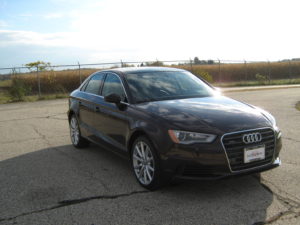 6.20: 2015-2016 Audi A3
6.20: 2015-2016 Audi A3
The Audi A3 is the current reigning king of rollover resistance among luxury cars currently available in the United States and tested by the IIHS. It’s capable of supporting more than 6x its weight before caving in by 5 inches, which translates to a “peak force” of 19,325 lbs, or more than three times the weight of a Chevy Suburban. It’s important to note that while this isn’t the highest peak force of any car on the market, the strength-to-weight ratio (6.20), or SWR, is what matters in a rollover, as weights aren’t being lowered onto the car; the forces the car experiences will be tied to the weight of the vehicle as it rolls over itself in a crash. In other words, if this were a fitness test, the challenge wouldn’t involve how much you could bench press; it would involve the number of push-ups you could do.
The A3’s parent company, Volkswagen, is also behind the Passat, which is currently the best non-luxury car you can be in during a rollover with an SWR of 6.32. Despite VW’s emissions corruption, they’re clearly doing good work when it comes to rollover safety (presuming they haven’t found a way to game this test as well).
Because the A3 was never rated by the IIHS until the 2015 model year, there unfortunately aren’t previous generations available for shoppers interested in saving money.
My full 3 across car seat guide to the A3 is pending.
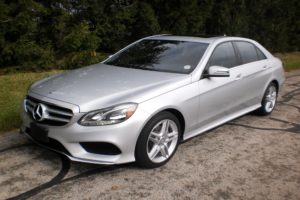 5.40: 2010-2016 Mercedes-Benz E-Class Sedan
5.40: 2010-2016 Mercedes-Benz E-Class Sedan
When it comes to roof strength in a large car, there isn’t a car that’s tested better yet than the MB E-Class sedan. It’s capable of supporting close to 5 and a half times its own weight before caving in by 5 inches. This is by far and away the best option available today among the biggest cars you can buy (although it will be interesting to see how Volvo scores when the S90 / V90 become available). The “peak force” tested value was equivalent to 20,961 lbs, or more than three times the weight of a Ford F-150. As an aside, the 2010-2016 MB-E Class is also one of the best cars you can buy to keep you safe in a side impact collision; this is a very impressive vehicle all around.
If you’re looking to save money, you might want to consider the ML E-Class sedan from 2005 onward, as it features ESC and roll-sensitive side airbags from then on. Unfortunately, you can’t go prior to the current generation and get all three safety factors I advocate for above, however, as the E-Class’s roof was never tested by the IIHS until 2010. That said, it’s worth noting that the ’05-’08 E-Class 4WD was estimated to have a driver death rate of 0 by the IIHS, while the FWD E-Class had a DDR of 12 (with zero estimated rollover deaths) which only reemphasizes the safety of the vehicle and its drivers across various generations.
My full 3 across car seat guide to the MB E-Class sedan is here.
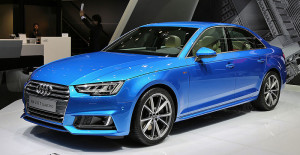 5.34: 2017 Audi A4
5.34: 2017 Audi A4
Hot on the heels of the E-Class sedan is the A4, which is the second entry by Audi into the rollover-resistant rankings. Like every car on this list, it features good moderate and small front overlap scores, good side impact scores, ESC, rollover-sensing side airbags, and a roof capable of supporting at least 5x its weight before caving in; in this case, the SWR is 5.34.
If you’re looking to save money with an older generation, you’ll be pleased with the back catalog of the A4; the 2009-2016 model years featured a strong roof with a 4.60 SWR, ESC, and side airbags; the downside is that the side airbags did not become roll-sensitive until the 2017 model year. If you’re on an even smaller budget, you can go back to the 2002 model year and still get side airbags and ESC, although you won’t get a roof score until 2009.
As an aside, the 2008-2011 model years of the A4 4WD were also estimated by the IIHS to have had a zero driver death rate, despite not having rollover-sensitive side airbags. This is a safe car, and it has a safe history.
My full 3 across car seat guide to the A4 is here.
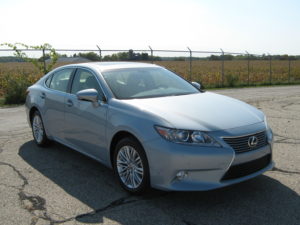 5.22: 2013-2016 Lexus ES
5.22: 2013-2016 Lexus ES
The ES is the third and final mid-sized luxury car to make the list after the A3 and A4, and does a great job with a strong SWR of 5.22. It’s important to note, however, that the side airbags are only rollover-sensing from 2016 onward; before then, they’re regular side airbags.
The back catalog of the ES will also be pleasing to families interested in savings, as it is the only vehicle on the list that features a great (5+) SWR in its prior generation. In fact, the SWR from 2007-2012 is 5.18x, and you also get side airbags (though without the rollover sensor) and ESC in all of those years, making this a great used vehicle option for rollover safety.
My full 3 across car seat guide to the ES is here.
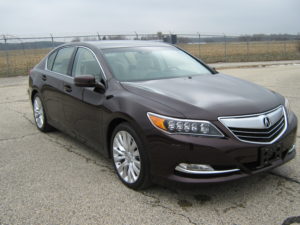 5.18: 2014-2016 Acura RLX
5.18: 2014-2016 Acura RLX
The RLX is an excellent choice for families interested in one of the safest large cars on the road, with a roof capable of supporting 5.18x its weight before caving in.
Unlike with the MB E-Class, there isn’t a previous-generation RLX to look through for savings; however, since the strengths in this model date back to model year 2014, you might be able to find significant savings in the used market.
My full 3 across car seat guide to the RLX is here.
In conclusion, any of these luxury cars will be among the absolute safest you can be in during a rollover today. They feature ESC to reduce the risks of rollover involvement to begin with, rollover-sensitive side airbags to protect you should rollovers occur, and strong roofs to preserve your occupant space and allow your seat belts and side airbags to do their jobs while the rollover occurs. These are life-saving technologies, and we’re blessed to live in an era where they exist and are widely available and increasingly affordable.
What do I do if the luxury car I bought or am considering wasn’t on the list?
Due to space constraints, I focused on only listing the best of the best luxury sedans currently available for rollover protection. This doesn’t mean that these are the only safe cars out there right now. Any car with a SWR of 4.0 or higher, ESC, and roll-sensitive side airbags is already going to provide a large amount of protection if you’re unfortunate enough to get into a rollover situation.
If you’re considering an car that doesn’t have the features above, you’ll want to make sure you’ve got ESC at an absolute minimum, followed by a strong roof, and roll-sensitive side airbags. If you have to choose between a strong roof and roll-sensitive airbags, I’d go with the roof score, presuming you have side airbags in both vehicles. However, ESC is by far the most important of the three technologies to have, as prevention is always better than having to deal with the cure, and avoiding a rollover is much better than having technology to increase your odds of surviving it once it’s already occurring.
We can’t control everything. The safest option is still not driving at all, followed by driving as little as possible. But if you’ve got to drive, drive safely, and do your best to choose a safe vehicle. If you’re going to use it with children, definitely check out the plethora of best practice articles I’ve written here on choosing safe car seats, installation tips, seat reviews, and more information to help you make informed decisions.
I loved writing this article, and I hope you enjoyed reading it. I look forward to writing more articles examining various factors in car safety design and how they relate to keeping you and your loved ones safer while on the road. Stay tuned, remember to avoid common mistakes parents make with car seats, and check out some 3 across car seat guides while you’re here.
If you find the information on car safety, recommended car seats, and car seat reviews on this car seat blog helpful, you can shop through this Amazon link for any purchases, car seat-related or not. Canadians can shop through this link for Canadian purchases.

